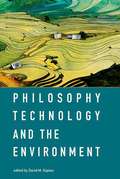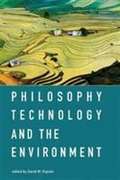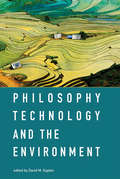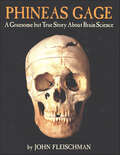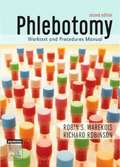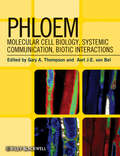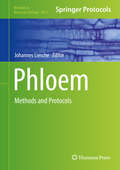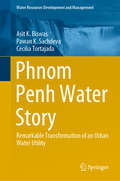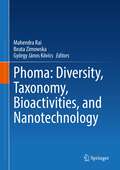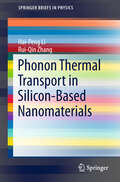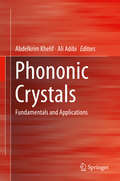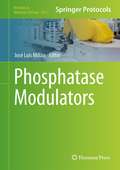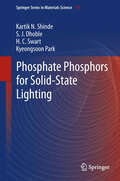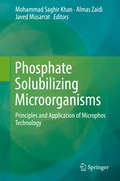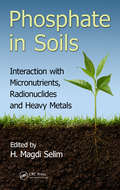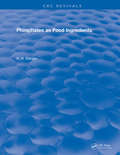- Table View
- List View
Philosophy, Technology, and the Environment
by David M. KaplanEnvironmental philosophy and philosophy of technology have taken divergent paths despite their common interest in examining human modification of the natural world. Yet philosophers from each field have a lot to contribute to the other. Environmental issues inevitably involve technologies, and technologies inevitably have environmental impacts. In this book, prominent scholars from both fields illuminate the intersections of environmental philosophy and philosophy of technology, offering the beginnings of a rich new hybrid discourse. All the contributors share the intuition that technology and the environment overlap in ways that are relevant in both philosophical and practical terms. They consider such issues as the limits of technological interventions in the natural world, whether a concern for the environment can be designed into things, how consumerism relates us to artifacts and environments, and how food and animal agriculture raise questions about both culture and nature. They discuss, among other topics, the pessimism and dystopianism shared by environmentalists, environmental philosophers, and philosophers of technology; the ethics of geoengineering and climate change; the biological analogy at the heart of industrial ecology; green products and sustainable design; and agriculture as a bridge between technology and the environment.ContributorsBraden Allenby, Raymond Anthony, Philip Brey, J. Baird Callicott, Brett Clark, Wyatt Galusky, Ryan Gunderson, Benjamin Hale, Clare Heyward,Don Idhe, Mark Sagoff, Julian Savulescu, Paul B. Thompson, Ibo van de Poel, Zhang Wei,Kyle Powys Whyte
Philosophy, Technology, and the Environment
by David M. KaplanEnvironmental philosophy and philosophy of technology have taken divergent paths despite their common interest in examining human modification of the natural world. Yet philosophers from each field have a lot to contribute to the other. Environmental issues inevitably involve technologies, and technologies inevitably have environmental impacts. In this book, prominent scholars from both fields illuminate the intersections of environmental philosophy and philosophy of technology, offering the beginnings of a rich new hybrid discourse. All the contributors share the intuition that technology and the environment overlap in ways that are relevant in both philosophical and practical terms. They consider such issues as the limits of technological interventions in the natural world, whether a concern for the environment can be designed into things, how consumerism relates us to artifacts and environments, and how food and animal agriculture raise questions about both culture and nature. They discuss, among other topics, the pessimism and dystopianism shared by environmentalists, environmental philosophers, and philosophers of technology; the ethics of geoengineering and climate change; the biological analogy at the heart of industrial ecology; green products and sustainable design; and agriculture as a bridge between technology and the environment.ContributorsBraden Allenby, Raymond Anthony, Philip Brey, J. Baird Callicott, Brett Clark, Wyatt Galusky, Ryan Gunderson, Benjamin Hale, Clare Heyward,Don Idhe, Mark Sagoff, Julian Savulescu, Paul B. Thompson, Ibo van de Poel, Zhang Wei,Kyle Powys Whyte
Philosophy, Technology, and the Environment (The\mit Press Ser.)
by David KaplanContributions by prominent scholars examining the intersections of environmental philosophy and philosophy of technology.Environmental philosophy and philosophy of technology have taken divergent paths despite their common interest in examining human modification of the natural world. Yet philosophers from each field have a lot to contribute to the other. Environmental issues inevitably involve technologies, and technologies inevitably have environmental impacts. In this book, prominent scholars from both fields illuminate the intersections of environmental philosophy and philosophy of technology, offering the beginnings of a rich new hybrid discourse. All the contributors share the intuition that technology and the environment overlap in ways that are relevant in both philosophical and practical terms. They consider such issues as the limits of technological interventions in the natural world, whether a concern for the environment can be designed into things, how consumerism relates us to artifacts and environments, and how food and animal agriculture raise questions about both culture and nature. They discuss, among other topics, the pessimism and dystopianism shared by environmentalists, environmental philosophers, and philosophers of technology; the ethics of geoengineering and climate change; the biological analogy at the heart of industrial ecology; green products and sustainable design; and agriculture as a bridge between technology and the environment.ContributorsBraden Allenby, Raymond Anthony, Philip Brey, J. Baird Callicott, Brett Clark, Wyatt Galusky, Ryan Gunderson, Benjamin Hale, Clare Heyward, Don Idhe, Mark Sagoff, Julian Savulescu, Paul B. Thompson, Ibo van de Poel, Zhang Wei, Kyle Powys Whyte
Phineas Gage: A Gruesome but True Story About Brain Science
by John FleischmanPhineas Gage was truly a man with a hole in his head. Phineas, a railroad construction foreman, was blasting rock near Cavendish, Vermont, in 1848 when a thirteen-pound iron rod was shot through his brain. Miraculously, he survived to live another eleven years and become a textbook case in brain science.At the time, Phineas Gage seemed to completely recover from his accident. He could walk, talk, work, and travel, but he was changed. Gage "was no longer Gage," said his Vermont doctor, meaning that the old Phineas was dependable and well liked, and the new Phineas was crude and unpredictable.His case astonished doctors in his day and still fascinates doctors today. What happened and what didn&’t happen inside the brain of Phineas Gage will tell you a lot about how your brain works and how you act human.
Phineas L. MacGuire . . . Blasts Off!
by Frances O'Roark Dowell Preston McdanielsHouston,we have a problem! Phineas L. MacGuire (a.k.a. Mac) is less than up-to-date on planetary happenings. (Marsquakes? Who knew?) If he's going to be the best scientist in the fourth grade, Mac has to set his sights pretty high. To outer space, actually. But Space Camp is expensive. Where is he going to find enough money for a week on Mars (or a pretty close simulation thereof)? Houston, we have another problem: a gigantic, slobbery dog named Lemon Drop. Mac can earn the money he needs by walking Mrs. McClosky's yellow Lab, but first he needs to survive the walks and the slobber! Good thing Mac is a scientific genius with friends like Ben and Aretha. Together the three of them discover that Lemon Drop is no ordinary dog -- that Lab is a real-life Lab-oratory.
Phineas L. MacGuire . . . Gets Cooking!
by Frances O'Roark Dowell Preston McdanielsChemistry in the kitchen? Phineas L. MacGuire applies his science skills to culinary creations in this food-tastic tale from the bestselling author of Chicken Boy.Phineas L. MacGuire--scientist extraordinaire--has a new chore: cooking dinner every night. He may be a genius, but he knows nothing about following a recipe. A pinch? A dash? A smidge? This doesn't seem very scientific. A pound of spaghetti? Salt on brownies? Lemon in biscuits? Why, these recipes look a little funky. But he'd better learn quickly if he and his friends are going to win the $10,000 Bake-Off prize. And to complicate matters, school bully Evan Forbes has taken a liking to Phineas's brownies...too much of a liking. As in, if Phineas can't make Evan enough brownies, he'll get clobbered for sure. Fortunately for Phineas, he has the help of his friends, and even better, he soon discovers that cooking is kind of like chemistry. So the whole recipe thing might just work out--as long as he can keep his cool in the kitchen.
Phlebotomy Worktext and Procedure Manual (Second Edition)
by Richard Robinson Robin S. WarekoisThe book provides a complete introduction to the practice of phlebotomy in all its aspects.
Phloem
by Aart J.E. van Bel Gary A. ThompsonPhloem: Molecular Cell Biology, Systemic Communication, Biotic Interactions is a timely collection of research on the cellular and molecular biology of this plant vascular tissue. Recent advances in phloem research have revealed the centrality of this plant tissue to whole plant development and physiology. Building on advances made through developments of new analytical technologies, this book will provide readers with a current and comprehensive reference on the role of phloem in plant growth and development. Collecting the work of a global team of leading researchers, Phloem will provide the reader with a valuable synthesis of the latest research in a single volume.
Phloem: Methods and Protocols (Methods in Molecular Biology #2014)
by Johannes LiescheThis detailed book presents methods that enable the determination of parameters relevant to phloem research in the most efficient ways, putting plant scientists with access to adequate instrumentation in the position to answer any phloem-related question. The collection explores techniques that have been used for decades, such as tracing phloem transport with carbon isotopes, as well as recent developments, such as esculin-based assays of phloem transport and super-resolution microscopy of phloem proteins. As such, the book presents the state-of-the-art in phloem research and, at the same time, a starting point for the development of new methods that will fill the remaining gaps in the phloem researcher’s toolbox in the future. Written for the highly successful Methods in Molecular Biology series, chapters include introductions to their respective topics, lists of the necessary materials and reagents, step-by-step, readily reproducible protocols, and tips on troubleshooting and avoiding known pitfalls. Authoritative and comprehensive, Phloem: Methods and Protocols is an ideal guide for all researchers exploring this challenging area of plant biology.
Phnom Penh Water Story: Remarkable Transformation of an Urban Water Utility (Water Resources Development and Management)
by Asit K. Biswas Cecilia Tortajada Pawan K. SachdevaThis book analyses how a water utility from a developing country, Phnom Penh Water Supply Authority, that was totally dysfunctional, corruption-ridden and literally bankrupt in 1993, became one of the most successful water utilities of the developing world in only about 15 years. By 2010, some of the performance indicators of this public sector utility were even better than London, Paris or Los Angeles. The book further analyses the enabling conditions that made this remarkable transformation possible. Based on this analysis, a framework is recommended for water utilities from developing countries so that they can also be transformed into functional, efficient, equitable and financially viable institutions on a sustainable basis.
Phoenix Rising
by Karen HesseNyle Sumner is an orphan. And in spite of the fact that she and her grandmother live a good life on a Vermont sheep farm, she cannot forget that her father abandoned her. She cannot forget that her mother died in the back room of the farmhouse when Nyle was six. And she cannot forget that her grandfather died in that same room, just a few years ago. When there's an explosion at a nearby nuclear plant, a woman and her fifteen-year-old son seek refuge in Nyle's house. Ezra Trent has been severely poisoned with radiation, and Nyle is sure that he will die in the back room, just like the others. She'd rather not get to know him; rather not let his death affect her. But somehow inside, Nyle knows she must try to help this person--that his life depends on it.
Phoenix Rising (Phoenix Ser. #1)
by Bryony PearceSail. Salvage. Repeat.For as long as Toby can remember, he and his father have sailed on the Phoenix, salvaging from the junk-filled seas to stay afloat, while keeping under the radar of the authorities. His father is, after all, a wanted man.And now the Phoenix is on the trail of the ultimate prize: a salvage of solar panels that could mean they’ll never need to hunt for fuel again.Ayla is second-in-command on the rival Banshee, where she’s trained her whole life to fight-just as her mother, Captain Nell, demands. Since childhood, Ayla’s been taught the Phoenix must be destroyed. With the ship in their sights, her crew is desperate to have the precious intel, too.Toby’s sick of a life at sea, and Ayla may be his only hope. Can he turn an old feud into a new alliance that will save both their skins?Award-winning author Bryony Pearce brings the high seas to life with her rousing steampunk pirate adventure that will have you craving more.
Phoenix Zones: Where Strength Is Born and Resilience Lives
by Hope FerdowsianFew things get our compassion flowing like the sight of suffering. But our response is often shaped by our ability to empathize with others. Some people respond to the suffering of only humans or to one person’s plight more than another’s. Others react more strongly to the suffering of an animal. These divergent realities can be troubling—but they are also a reminder that trauma and suffering are endured by all beings, and we can learn lessons about their aftermath, even across species. With Phoenix Zones, Dr. Hope Ferdowsian shows us how. Ferdowsian has spent years traveling the world to work with people and animals who have endured trauma—war, abuse, displacement. Here, she combines compelling stories of survivors with the latest science on resilience to help us understand the link between violence against people and animals and the biological foundations of recovery, peace, and hope. Taking us to the sanctuaries that give the book its title, she reveals how the injured can heal and thrive if we attend to key principles: respect for liberty and sovereignty, a commitment to love and tolerance, the promotion of justice, and a fundamental belief that each individual possesses dignity. Courageous tales show us how: stories of combat veterans and wolves recovering together at a California refuge, Congolese women thriving in one of the most dangerous places on earth, abused chimpanzees finding peace in a Washington sanctuary, and refugees seeking care at Ferdowsian’s own medical clinic. These are not easy stories. Suffering is real, and recovery is hard. But resilience is real, too, and Phoenix Zones shows how we can foster it. It reveals how both people and animals deserve a chance to live up to their full potential—and how such a view could inspire solutions to some of the greatest challenges of our time.
Phoma: Diversity, Taxonomy, Bioactivities, and Nanotechnology
by Mahendra Rai Beata Zimowska György János KövicsThe book covers the taxonomy, diversity, bioactivity, and nanotechnology involved in the study of the genus Phoma. It presents the most recent molecular taxonomic approach, secondary metabolites, different bioactivities, combating microbial threats, and its use in nanotechnology from a basic research to an applied perspective. Expert contributors provide the latest research and applications to present thorough coverage of this important genus in human and plant pathology and the disease management.
Phone-y Friends (Project Droid)
by Nancy Krulik Amanda Burwasser Mike MoranLogan auditions for the school play and is chosen for the role of Chipmunk Number Three, but unfortunately, Java, Logan's robot cousin, doesn't get a part, which means he and Logan won't be hanging out together every day after school. Logan's excited to have something to himself and starts spending more and more time with his new friends.Now with so much time on his hands, Java is determined to make some new friends, too--the dishwasher, the electric mixer, the refrigerator . . . But his favorite new friend is Spike, the voice activated program on Mrs. Applebaum's cell phone. While Java can't be in the play, he ends up helping out with building the sets, and almost blows his cover! But when Logan freezes and forgets his lines on stage, and Java (who has memorized them in an instant) feeds them to him the Cyrano-style, it's the android who saves the day. After all, that's what friends are for.Internationally bestselling author Nancy Krulik and her incredibly talented daughter, Amanda Burwasser, spin hilarious high jinks in the fourth book in the Project Droid series, which combines the literalness of Amelia Bedelia with a wacky modern edge, making for hours of laughter. And the fun continues with an activity in the back!
Phones Keep Us Connected (Let's-Read-and-Find-Out Science 2)
by Kathleen Weidner ZoehfeldRead and find out about the science, technology, and history of how phones work in this colorfully illustrated nonfiction picture book."A well-explained, informative presentation on the telephone’s historical development as well as how cell phones work. Featuring a diverse crew of characters, the upbeat digital illustrations are attractive and, equally important, very helpful in showing hard-to-visualize concepts." (Booklist starred review)Phones Keep Us Connected includes a glossary, a find out more section with an activity about building a string telephone, and an infographic about the history of the phone.Questions addressed in this book include:How was the phone invented?How has it changed?How can a phone carry your voice across oceans?Read and find out in the proven winner Phones Keep Us Connected!This is a Level 2 Let's-Read-and-Find-Out, which means the book explores more challenging concepts for children in the primary grades. The 100+ titles in this leading nonfiction series are:hands-on and visualacclaimed and trustedgreat for classroomsTop 10 reasons to love LRFOs:Entertain and educate at the same timeHave appealing, child-centered topicsDevelopmentally appropriate for emerging readersFocused; answering questions instead of using survey approachEmploy engaging picture book quality illustrationsUse simple charts and graphics to improve visual literacy skillsFeature hands-on activities to engage young scientistsMeet national science education standardsWritten/illustrated by award-winning authors/illustrators & vetted by an expert in the fieldOver 130 titles in print, meeting a wide range of kids' scientific interestsBooks in this series support the Common Core Learning Standards, Next Generation Science Standards, and the Science, Technology, Engineering, and Math (STEM) standards. Let's-Read-and-Find-Out is the winner of the American Association for the Advancement of Science/Subaru Science Books & Films Prize for Outstanding Science Series.
Phonological Disorders in Children: Theory, Research and Practice (Psychology Library Editions: Speech and Language Disorders)
by Mehmet S. YavasOriginally published in 1991, the recent developments in the study of phonological disorders in children had led to a fruitful interaction between speech pathology and phonology. It is one aspect of the application of linguistic theory to the study of speech and language disorders which had opened up a new field, clinical linguistics. This book brings together the concerns of the linguist and the speech pathologist; the essays chosen share the quality of not discussing theory or therapy without addressing the implications one has for the other. By concentrating on recent work the editor hoped to stimulate further discussion in this important and fast growing area of research.
Phonon Thermal Transport in Silicon-Based Nanomaterials (SpringerBriefs in Physics)
by Rui-Qin Zhang Hai-Peng LiIn this Brief, authors introduce the advance in theoretical and experimental techniques for determining the thermal conductivity in nanomaterials, and focus on review of their recent theoretical studies on the thermal properties of silicon–based nanomaterials, such as zero–dimensional silicon nanoclusters, one–dimensional silicon nanowires, and graphenelike two–dimensional silicene. The specific subject matters covered include: size effect of thermal stability and phonon thermal transport in spherical silicon nanoclusters, surface effects of phonon thermal transport in silicon nanowires, and defects effects of phonon thermal transport in silicene. The results obtained are supplemented by numerical calculations, presented as tables and figures. The potential applications of these findings in nanoelectrics and thermoelectric energy conversion are also discussed. In this regard, this Brief represents an authoritative, systematic, and detailed description of the current status of phonon thermal transport in silicon–based nanomaterials. This Brief should be a highly valuable reference for young scientists and postgraduate students active in the fields of nanoscale thermal transport and silicon-based nanomaterials.
Phononic Crystals
by Abdelkrim Khelif Ali AdibiThis book provides an in-depth analysis as well as an overview of phononic crystals. This book discusses numerous techniques for the analysis of phononic crystals and covers, among other material, sonic and ultrasonic structures, hypersonic planar structures and their characterization, and novel applications of phononic crystals. This is an ideal book for those working with micro and nanotechnology, MEMS (microelectromechanical systems), and acoustic devices. This book also: Presents an introduction to the fundamentals and properties of phononic crystals Covers simulation techniques for the analysis of phononic crystals Discusses sonic and ultrasonic, hypersonic and planar, and three-dimensional phononic crystal structures Illustrates how phononic crystal structures are being deployed in communication systems and sensing systems
Phononic and Electronic Excitations in Complex Oxides Studied with Advanced Infrared and Raman Spectroscopy Techniques (Springer Theses)
by Fryderyk LyzwaThis PhD thesis reports on investigations of several oxide-based materials using advanced infrared and Raman spectroscopy techniques and in combination with external stimuli such as high magnetic or electric field, sptial confinement in thin film heterostructures and the radiation with UV light. This leads to new results in the fields of superconductivity, electronic polarization states and nanoscale phenomena.Among these, the observation of anomalous polar moments is of great relevance for understanding the electric-field-induced metal-to-insulator transistion; and the demonstration that confocal Raman spectroscopy of backfolded acoustic photons in metal-oxide multilayers can be used as a powerful characterization tool for monitoring their interface properties and layer thickness is an important technical development for the engineering of such functional oxide heterostructures.
Phosphatase Modulators
by José Luis MillánDriving further the research on mammalian alkaline phosphatase structure and function, Phosphatase Modulators collects expert contributions into one "how to" manual for basic scientists interested in initiating a drug discovery effort. While this book contains the traditional method chapters and some typical reviews on the structure and known functions of phosphatases, other contributions are meant to discuss approaches and alternatives useful in making "go/no-go" decisions in high throughput screening (HTS) and lead optimization campaigns. Many chapters focus on tissue-nonspecific alkaline phosphatase (TNAP) as well as protein phosphatases. Written for the highly successful Methods in Molecular Biology series, chapters in this volume include the kind of detail and key implementation advice that promotes reproducible results. Step-by-step and practical, Phosphatase Modulators offers a path to understanding many of the facets and complexities associated with undertaking a drug discovery effort and will serve as a roadmap to initiating those efforts.
Phosphate Phosphors for Solid-State Lighting
by H. C. Swart Kartik N. Shinde Kyeongsoon Park S. J. DhobleThe idea for this book arose out of the realization that, although excellent surveys and a phosphor handbook are available, there is no single source covering the area of phosphate based phosphors especially for lamp industry. Moreover, as this field gets only limited attention in most general books on luminescence, there is a clear need for a book in which attention is specifically directed toward this rapidly growing field of solid state lighting and its many applications. This book is aimed at providing a sound introduction to the synthesis and optical characterization of phosphate phosphor for undergraduate and graduate students as well as teachers and researchers. The book provides guidance through the multidisciplinary field of solid state lighting specially phosphate phosphors for beginners, scientists and engineers from universities, research organizations, and especially industry. In order to make it useful for a wide audience, both fundamentals and applications are discussed, together.
Phosphate Solubilizing Microorganisms
by Javed Musarrat Almas Zaidi Mohammad Saghir KhanThis book provides a comprehensive description of phosphate solubilizing microorganisms and highlights methods for the use of microphos in different crop production systems. The focus is on understanding both the basic and applied aspects of phosphate solubilizing microorganisms and how phosphorus-deficient soils can be transformed into phosphorus-rich ones by applying phosphate solubilizing microorganisms. The interaction of rhizosphere phosphate solubilizing microorganisms and environmental variables, as well as their importance in the production of crops such as legumes, cereals, vegetables etc. are discussed and considered. The use of cold-tolerant phosphate solubilizing microorganisms to enhance crop productivity in mountainous regions is examined, as are the ecological diversity and biotechnological implications of phosphate solubilizing microorganisms. Lastly, the role of phosphate solubilizing microorganisms in aerobic rice cultivation is highlighted. This volume offers a broad overview of plant disease management using phosphate solubilizing microbes and presents strategies for the management of cultivated crops. It will therefore be of special interest to both academics and professionals working in the fields of microbiology, soil microbiology, biotechnology and agronomy, as well as the plant protection sciences. This timely reference book provides an essential and comprehensive source of material, as it includes recent findings on phosphate solubilizing microorganisms and their role in crop production.
Phosphate in Soils: Interaction with Micronutrients, Radionuclides and Heavy Metals (Emergent Environmental Pollution)
by H. Magdi SelimEdited by One of the Best Specialists in Soil ScienceRecent studies reveal that Phosphorus (P) in the form of phosphate, a macronutrient essential for plant growth, and crop yields can influence the bioavailability, retention, and mobility of trace elements, metal(loid)s, and radio nuclides in soils. When this occurs, phosphates can affect the dynamics of heavy metals and influence soil characteristics, impacting soil mobility and toxicity. Phosphate in Soils: Interaction with Micronutrients, Radionuclides and Heavy Metals utilizes the latest research to emphasize the role that phosphate plays in enhancing or reducing the mobility of heavy metals in soil, and the soil-water-plant environment. It provides an in-depth understanding of each heavy metal species, and expands on phosphate interactions in geological material.Composed of 12 chapters, this text: Provides an overview of the reactions of metal(loid)s and common P compounds that are used as fertilizer in soils Emphasizes the effect of phosphorus on copper and zinc adsorption in acid soils Discusses findings on the influence of phosphate compounds on speciation, mobility, and bioavailability of heavy metals in soils as well as the role of phosphates on in situ and phytoremediation of heavy metals for contaminated soils Places emphasis on the influence of phosphate on various heavy metals species in soils, and their solubility/mobility and availability Provides extensive information on testing various high phosphate materials for remediation of heavy metal, micronutrients, and radionuclides contaminated sites Explores the reactivity of heavy metals, micronutrients and radionuclides elements in several soils Presents a case study illustrating various remediation efforts of acidic soils and remediation of Cu, Zn, and lead (Pb) contaminated soils around nonferrous industrial plants Emphasizes the significance of common ions (cations and anions) on phosphate mobility and sorption in soils, and more The author includes analytical and numerical solutions along with hands-on applications, and addresses other topics that include the transport and sorption modeling of heavy metals in the presence of phosphate at different scales in the vadose zone.
Phosphates As Food Ingredients
by R.H. EllingerThere is an enormous quantity of literature, including numerous patents, on the functions and applications of phosphates in foods. No attempt has been made to review every publication, as such an exhaustive review would require a sizeable book. Anyone interested in further details on any topic covered in this treatise should consult the references listed at the end of the chapter. The bibliographies provided in the references for each topic should provide more thorough coverage. It is hoped that the references cited are those with the most useful information on the phosphate applications and their effects on foods.
